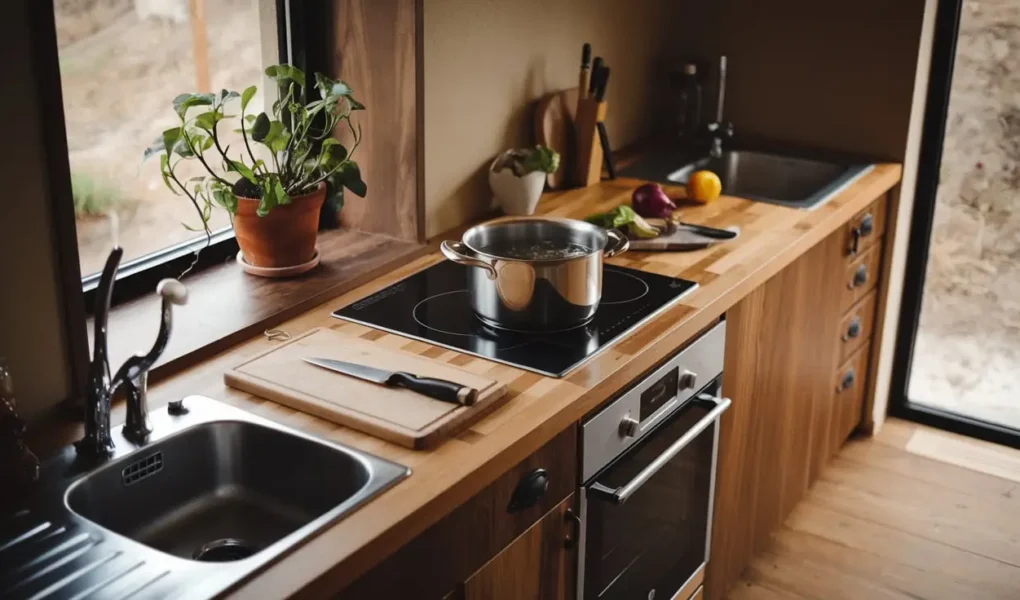Cooking at home is a rewarding skill. It saves money, promotes healthier eating, and allows for creativity in the kitchen. Whether you’re a beginner or an experienced cook, mastering the essentials is key. The Kitchen Basics WebQuest is designed to help you learn and develop these foundational skills. In this article, we’ll guide you through the most important techniques, tools, and tips for every home cook to feel confident and efficient in the kitchen.
Understanding Kitchen Safety
Before cooking, it’s crucial to understand kitchen safety. Simple safety practices can prevent accidents and ensure a smooth cooking experience.
- Knife Safety: Always cut away from your body and use a stable cutting board. Keep your knives sharp to prevent slipping.
- Heat Awareness: Use oven mitts to handle hot pans. Be mindful of stovetop burners.
- Fire Safety: Keep a fire extinguisher nearby. Never leave cooking unattended, especially when frying or grilling.
- Hygiene: Wash your hands before handling food, and clean surfaces regularly to prevent cross-contamination.
Action Step: Create a kitchen safety checklist. Review it before each cooking session to make safety a habit.
Mastering Basic Knife Skills
One of the most important skills in the kitchen is mastering how to handle a knife. Knife skills not only make cooking more efficient but also improve the presentation of your dishes.
- Grip the Knife Properly: Hold the handle with your dominant hand, using a firm grip. Rest your other hand on top of the food for stability.
- Basic Cuts: Learn simple techniques like dicing, chopping, slicing, and julienning. Each cut has its purpose, so understanding them is key.
- Practice Makes Perfect: Start with soft vegetables like cucumbers and gradually work your way up to harder items like carrots or potatoes.
Action Step: Practice your knife skills by chopping vegetables for a simple salad or stir-fry. Focus on consistent sizes for even cooking.
Choosing the Right Cookware
Investing in quality cookware is essential for every home cook. With the right pots, pans, and utensils, cooking becomes easier and more enjoyable.
- Pots and Pans: Start with basic items like a non-stick frying pan, a medium-sized saucepan, and a large stockpot. These will cover most of your cooking needs.
- Utensils: Essential utensils include a spatula, tongs, wooden spoons, and a whisk. These tools help with stirring, flipping, and mixing ingredients.
- Material Matters: Stainless steel is durable and easy to clean. Non-stick pans are great for beginners because they prevent food from sticking.
Action Step: Take stock of your kitchen tools. If you’re missing any essentials, invest in high-quality items that will last.
Understanding Cooking Methods
Different cooking methods bring out unique flavors and textures in food. Understanding how to use these techniques will elevate your cooking.
- Sautéing: This method uses a small amount of oil or butter in a pan over medium-high heat. It’s great for cooking vegetables and thin cuts of meat quickly.
- Roasting: Roasting uses dry heat, typically in an oven, to cook food evenly. It’s perfect for meats, potatoes, and vegetables.
- Boiling and Simmering: Boiling involves cooking food in rapidly bubbling water, while simmering uses a lower heat for a gentle cook. These methods are ideal for pasta, soups, and stews.
Action Step: Experiment with different cooking methods. Try roasting vegetables one day and sautéing them another to see the difference in flavor and texture.
Mastering Seasoning and Flavoring
Seasoning is what transforms a bland dish into something delicious. Knowing how to properly season your food will enhance every meal.
- Salt and Pepper: These are the foundation of good seasoning. Add them gradually as you cook and taste as you go.
- Herbs and Spices: Fresh herbs like basil and parsley add brightness, while dried spices like cumin and paprika bring depth. Don’t be afraid to experiment with new flavors.
- Acid Balance: Vinegar or citrus juice can brighten up a dish, adding a fresh pop of flavor.
Action Step: Create your own seasoning blends. Start with a simple mix of salt, pepper, garlic powder, and paprika to add flavor to proteins or vegetables.
Meal Planning and Preparation
Meal planning is a great way to save time and reduce stress in the kitchen. By preparing ingredients in advance, you’ll find cooking much easier and more enjoyable.
- Plan Ahead: Take a few minutes at the beginning of each week to decide what meals you want to cook. Make a list of ingredients you need.
- Batch Cooking: Prepare larger portions of food like grains, proteins, or roasted vegetables. Store them in the fridge for easy assembly throughout the week.
- Organize Your Kitchen: Keep your pantry, fridge, and freezer stocked with essential items like grains, canned goods, and frozen vegetables. This makes meal planning quicker and more efficient.
Action Step: Spend one hour each week prepping ingredients like chopping vegetables or marinating proteins. This will save you time on busy days.
How to Read and Follow a Recipe
Reading and following a recipe correctly is an essential skill for any home cook. A well-executed recipe results in delicious meals, while a missed step can lead to disappointment.
- Read the Recipe Fully: Before you start cooking, read through the entire recipe. This ensures you understand each step and have all necessary ingredients.
- Measure Accurately: Use proper measuring tools for dry and liquid ingredients. Eyeballing measurements can throw off the balance of a dish.
- Timing is Key: Pay attention to cooking times and temperatures. Setting timers helps ensure your food is cooked to perfection.
Action Step: Practice reading and following a new recipe this week. Focus on accuracy and timing to see how closely your results match the original.
Storing and Preserving Food
Proper food storage is critical for keeping your ingredients fresh and safe to eat. Knowing how to store and preserve food helps reduce waste and ensures you always have ingredients on hand.
- Label and Date: Always label containers with the contents and date before storing them in the fridge or freezer.
- Refrigeration Basics: Store perishable items like dairy, meats, and leftovers in airtight containers in the fridge. Keep fruits and vegetables in the crisper drawer.
- Freezing Food: When freezing items like meats or sauces, use freezer-safe bags and remove as much air as possible to prevent freezer burn.
Action Step: Organize your fridge and freezer this week. Label items and ensure everything is stored in the correct area to maximize freshness.
Balancing Nutrients in Meals
A balanced meal includes proteins, carbohydrates, and healthy fats. Learning how to balance these elements will help you create nutritious, satisfying dishes.
- Protein: This can come from meat, fish, eggs, beans, or tofu. Protein helps build and repair tissues.
- Carbohydrates: Include whole grains like brown rice, quinoa, or whole wheat pasta for energy.
- Healthy Fats: Olive oil, avocado, and nuts are excellent sources of healthy fats that support brain function and heart health.
Action Step: When planning meals, aim to include all three macronutrients—protein, carbs, and fats. This ensures your meals are both nutritious and filling.
Time Management in the Kitchen
Good time management can make cooking more enjoyable and less stressful. With practice, you’ll be able to prepare meals efficiently without feeling rushed.
- Multitask Wisely: While one dish is cooking, work on another element of the meal. For example, chop vegetables while a sauce is simmering.
- Prep Ahead: Save time by prepping ingredients in advance, like washing and cutting vegetables or marinating meat the night before.
- Stay Organized: Keep your kitchen space clean and organized as you cook. This helps you work faster and find what you need when you need it.
Action Step: Try cooking a complete meal while practicing time management. Focus on efficiency without compromising quality.
Learning to Adapt and Improvise
Not every meal goes according to plan. Learning how to adapt and improvise with the ingredients you have is an important skill for every home cook.
- Substitute Ingredients: If you don’t have a specific ingredient, look for a similar alternative. For example, use Greek yogurt instead of sour cream or swap spinach for kale.
- Adjust Seasoning: If a dish tastes bland, don’t be afraid to adjust the seasoning. A little salt, spice, or acid can dramatically improve the flavor.
- Make it Work: If a dish doesn’t turn out as expected, try to salvage it. Turn a burnt sauce into a base for a new dish or repurpose leftovers into something creative.
Action Step: Challenge yourself to cook a meal with ingredients you already have on hand. Use substitutions and improvisation to make it work.
Cleaning as You Cook
A clean kitchen makes cooking more enjoyable. Learning to clean as you cook keeps your workspace organized and saves time at the end of your meal preparation.
- Use Downtime: While waiting for something to cook or boil, take a few minutes to wash dishes, wipe counters, or put ingredients back where they belong.
- Clean Up Spills Immediately: Cleaning up spills as they happen prevents messes from becoming bigger problems later.
- Organize Your Space: Keep a trash can or compost bin nearby so you can easily discard waste without leaving your cooking area.
Action Step: Set a goal to keep your kitchen clean while cooking your next meal. Pay attention to keeping counters clear and dishes washed as you go.
Conclusion
The Kitchen Basics WebQuest equips you with essential skills to become a confident and capable home cook. From mastering knife skills and seasoning to learning time management and food storage, these foundational techniques are the key to success in the kitchen. By practicing these skills and incorporating them into your daily routine, you’ll not only improve your cooking but also enjoy the process more. Whether you’re just starting or looking to refine your abilities, this guide will help you navigate your kitchen with ease and confidence. Happy cooking!




